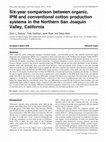Papers by diego alejandro castillon nieto
The article aims to understand how the dominant conceptualization of transnational crime legitima... more The article aims to understand how the dominant conceptualization of transnational crime legitimates non-traditional forms of warfare at the global level while itself constituting the idea of global civil society. It is argued that since this discourse defines transnational crime as a threat to global society, it makes politically viable the deployment of policing and military interventions in defence of the world population. In order to expose this, this article reconstructs the trajectories of the discourse on organized criminality. The article first analyses the emergence of the discourse in the United States during the 1950s, afterwards analysing it as an issue of transnational scope during the last two decades. Thus the aim here is to underline the importance that a phenomenon such as crime has had on the governance at a global level.
Centro de Estudios Interculturales. (2013). Análisis de la posesión territorial y situaciones de ... more Centro de Estudios Interculturales. (2013). Análisis de la posesión territorial y situaciones de tensión interétnica e intercultural en el departamento del Cauca. Recuperado de https://www.javerianacali.edu.co/sites/ujc/files/node/field-documents/ field_document_file/analisis_posesion_territorial_-_tensiones_interetnicas_e_ interculturales_en_el_cauca_1.pdf Chaves, M. (2005).

Compare: A Journal of Comparative and International Education, 2017
Understanding multilateral institutions' role in the construction of desirable goals for educatio... more Understanding multilateral institutions' role in the construction of desirable goals for educational reform is a key element to grasp the weight globalisation has on local practices of education. Comparative studies of civics and moral education point to the idea of 'citizenship' as a site revealing not only the political economy but also the cultural politics involved in the globalisation of education. Through political discourse analysis, this paper analyses key multilateral agencies' discourses on citizenship education for Latin America. It traces the concerns, diagnoses, definitions and proposals of what citizenship education is (or should be) in agenda-setting documents and policy reports promoted by these organisations. Drawing on Latin American decolonial theories, it challenges concerns with civic disengagement and convivencia underpinning multilateral citizenship education discourses. As a counterpoint, it presents research from scholars highlighting alternative-often overlooked-participatory and decolonial pedagogical experiences present in Latin America that open new standpoints for citizenship education comparative research in the region.

Curriculum Inquiry, 2017
ABSTRACT This paper discusses findings from focus groups with youth located in underprivileged su... more ABSTRACT This paper discusses findings from focus groups with youth located in underprivileged surroundings in one large multicultural city in Canada and in a moderately large city in Mexico, examining their understandings and lived experiences of migration-related conflicts. Canadian participants framed these conflicts as a problem of racist attitudes towards immigrants in an otherwise welcoming city. Mexican youth understood emigration as a questionable individual dream to overcome precarious economic conditions, bringing about violence to those travelling and family fractures for those who stay. We identify tensions between these dominant narratives about mobility and conflict – usually also present in intended curriculum – and students' first-hand, every day experiences with migration in each setting. We point out to youths' contrasting imaginaries of citizenship – sense of agency and identity positions – with regards to migration in each setting, showing the limited opportunities they have to make sense of their lived (globalized) conflicts beyond their own localized cultural explanations. We argue that connecting the recognition of cultural differences in the world with the power imbalances, unequal positions, and historically structured global inequities revealed by issues such as migration, must become a crucial effort in citizenship education on global issues.
Revista Española de Educación Comparada, 2016
Educación ciudadana y convivencia en contextos de violencia: desafíos transnacionales a la constr... more Educación ciudadana y convivencia en contextos de violencia: desafíos transnacionales a la construcción de paz en escuelas de México

Co-herencia, 2016
El presente texto realiza una reconstrucción de las influyentes contribuciones del politólogo Gui... more El presente texto realiza una reconstrucción de las influyentes contribuciones del politólogo Guillermo O’Donnell a los estudios sobre los procesos de democratización. Para ello, discute sus principales elaboraciones analíticas y conceptuales situándolas en el contexto político e histórico en el que se desarrollaron, así como frente a otros adelantos teóricos y discusiones ideológicas que les han seguido. En particular, esta revisión se concentra, primero, en el período de las transiciones a la democracia en América Latina, mostrando cómo los constructos teóricos desarrollados por O’Donnell estaban vinculados a las visiones políticas y los compromisos normativos más amplios de su parte. Tales compromisos se ven reflejados, posteriormente, en los intereses investigativos y apuestas conceptuales del autor durante el período post-transicional, específicamente en sus preocupaciones frente a la democracia delegativa y la accountability horizontal, elementos que ocupan la segunda parte de...

Revista Palmas, 2012
La necesidad de mejorar la eficiencia en la extracción de aceite y almendra en las plantas de ben... more La necesidad de mejorar la eficiencia en la extracción de aceite y almendra en las plantas de beneficio de aceite de palma colombianas, mediante la disminución en los niveles de pérdidas y los costos de procesamiento, hacen que el desarrollo de herramientas para el control y supervisión en áreas sensibles del proceso sea considerado hoy como un elemento imprescindible, tanto para los proyectos de mejora de las plantas existentes, como en el desarrollo de nuevos proyectos. Ese tipo de herramientas ha surgido de manera gradual, respondiendo a las necesidades más relevantes del proceso, principalmente en las secciones de esterilización, desfrutación, prensado y generación de vapor. En este documento, que es el resultado de la ponencia presentada durante la pasada Conferencia Internacional sobre palma de aceite, se presentan algunos ejemplos de automatismos desarrollados por personal técnico de la Planta Extractora Palmas del Cesar S.A., en la Zona Central, sus aplicaciones, beneficios y costos de aplicación.
Procedimiento para cultivo de hongos sobre pulpa agotada de alperujo (orujillo). Se describe en e... more Procedimiento para cultivo de hongos sobre pulpa agotada de alperujo (orujillo). Se describe en este documento un nuevo procedimien-to de cultivo de hongos que se caracteriza por el uso de la pulpa agotada de alperujo (orujillo) y de un plástico especial. Este procedimiento consta de cuatro fases diferentes: Preparación de un inóculo con orujillo, preparación de un sustrato para cultivo con orujillo, inoculación del sustrato (fase 2) con el inóculo (fase 1) y finalmente embolsado de la mezcla. En esta última fase se utiliza un plástico opaco con pequeñas porciones transparentes que permiten la inspección visual del desarrollo del hongo sin necesidad de manipulación de las bolsas. ES 2 379 835 A1

Peristenus relictus (Braconidae) was imported into California and released into the Monterey Bay ... more Peristenus relictus (Braconidae) was imported into California and released into the Monterey Bay region beginning summer 2002 for control of Lygus spp., a key pest of strawberries. They were last released in 2006. Beginning in 2009, we sampled for this parasitoid at increasing distances from original release sites to determine how far they have spread since first released. Lygus nymphs were collected from six locations on an expanding sampling radius, intermediate (ca. 30 km) and far (ca. 60 km) from the original release area, at three points on the compass, northwest, northeast, and southeast (the original release sites were within 10 km of the ocean, precluding sample sites to the west). Dissected larvae were identified to species using a novel multiplex PCR analysis of their DNA since a native Peristenus sp. has been found, though rarely, attacking Lygus spp. Peristenus relictus was found at the most distant locations, north and east of original release sites, and at the intermed...
Colombia Internacional, 2012
How to cite Complete issue More information about this article Journal's homepage in redalyc.org ... more How to cite Complete issue More information about this article Journal's homepage in redalyc.org Scientific Information System Network of Scientific Journals from Latin America, the Caribbean, Spain and Portugal Non-profit academic project, developed under the open access initiative
Primates in Fragments, 2013
ABSTRACT
Ubiquitous Computing and Ambient Intelligence. Personalisation and User Adapted Services, 2014
In this paper, we have focused on applying robotics as a social element and an intermediary in to... more In this paper, we have focused on applying robotics as a social element and an intermediary in tourism. To that end, a system has been developed that will benefit the tourist experience. To do this, every room of the hotel would have a low-cost social robot, a Karotz. This robot interacts orally with the tourist to provide him or her with news about the hotel and the best tourism activities for the user. The components of the robot were used during the development to make communication flows natural. This has enabled us to create a social robot that covers a need faced by the tourist industry. The developed prototype shows that this is a plausible field of application for social robotics.

Renewable Agriculture and Food Systems, 2007
Three different cotton production strategies [certified organic, conventionally grown, and reduce... more Three different cotton production strategies [certified organic, conventionally grown, and reduced insecticide input/integrated pest management (IPM)] were compared in field-sized replicates in the Northern San Joaquin Valley (NSJV), California, from 1996 to 2001. We measured arthropod abundance, plant development, plant density, pesticide use, cost of production, lint quality and yields in the three treatments. Overall pest abundance was low, and a key cotton fruit pest,Lygus hesperusKnight, known as the western tarnished plant bug (WTPB), did not exceed action thresholds in any treatment. Organic fields had significantly more generalist insect predators than conventional fields during at least one seasonal interval in all but one year. While there were no significant differences in plant development, plant densities at harvest were lower in organic than conventional and IPM fields. Some measures of lint quality (color grade and bale leaf rating) were also lower in the organic trea...
Facies, 2005
Page 1. Facies (2005) 51:350364 DOI 10.1007/s10347-004-0042-5 ORIGINAL ARTICLE Nora G. Cabaleri ... more Page 1. Facies (2005) 51:350364 DOI 10.1007/s10347-004-0042-5 ORIGINAL ARTICLE Nora G. Cabaleri · Claudia Armella · Diego G. Silva Nieto Saline paleolake of the Caæadón Asfalto Formation (Middle-Upper Jurassic), Cerro Cóndor, Chubut province ...

Environmental Entomology, 2014
Alfalfa trap crops are currently used to manage Lygus spp. in organic strawberry fields on the Ca... more Alfalfa trap crops are currently used to manage Lygus spp. in organic strawberry fields on the California Central Coast. The retention of Lygus spp. in alfalfa creates aggregated distributions that provide improved opportunities for biological control by the introduced parasitoid Peristenus relictus (Ruthe). The abundance and distribution of P. relictus between two trap crops separated by 50 strawberry rows were analyzed in 2008 and 2010. Parasitism of Lygus spp. nymphs by P. relictus (measured by larval abundance and % parasitism) was greatest in alfalfa trap crops compared with strawberry rows. A significantly positive correlation between host nymphs and P. relictus larvae in and between trap crops was found. Movement of P. relictus adults from a marked alfalfa trap crop into adjacent strawberry rows or trap crops was also studied in 2008 and 2009 using a chicken egg-albumin enzyme-linked immunosorbent assay mark-capture technique. In 2008 and 2009, 85 and 49% of protein-marked wasps were captured from central trap crops, respectively, indicating that alfalfa trap crops act as a concentrated &amp;amp;amp;amp;amp;amp;amp;amp;amp;amp;amp;amp;amp;amp;amp;amp;amp;amp;amp;amp;amp;amp;amp;amp;amp;amp;amp;amp;amp;amp;amp;amp;amp;amp;amp;amp;amp;amp;amp;amp;amp;amp;amp;amp;amp;amp;amp;amp;amp;amp;amp;amp;amp;amp;amp;amp;quot;host-density anchor&amp;amp;amp;amp;amp;amp;amp;amp;amp;amp;amp;amp;amp;amp;amp;amp;amp;amp;amp;amp;amp;amp;amp;amp;amp;amp;amp;amp;amp;amp;amp;amp;amp;amp;amp;amp;amp;amp;amp;amp;amp;amp;amp;amp;amp;amp;amp;amp;amp;amp;amp;amp;amp;amp;amp;amp;quot; in organic strawberry fields.










Uploads
Papers by diego alejandro castillon nieto